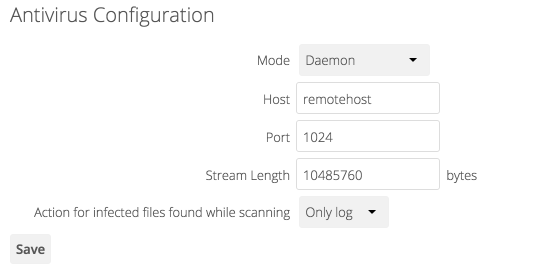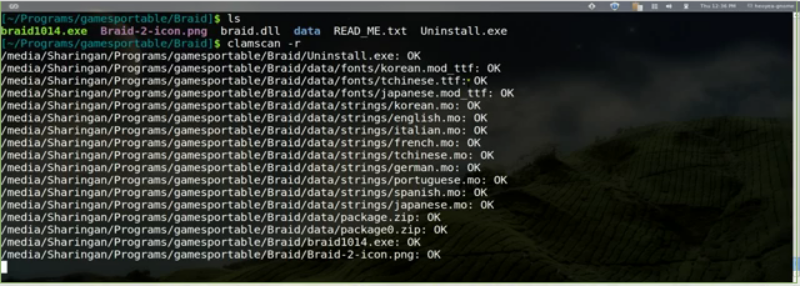Vcswatch reports that the current version of the package is not in its VCS. Either you need to push your commits and/or your tags, or the information about the package's VCS are out of date. A common cause of the latter issue when using the Git VCS is not specifying the correct branch when the packaging is not in the default one (remote HEAD branch), which is usually 'master' but can be. ClamAV includes a number of utilities: a command-line scanner, automatic database updater and a scalable multi-threaded daemon, running on an anti-virus engine from a shared library. The application also features a Milter interface for sendmail and on-demand scanning.
ClamXAV keeps threats at bay and puts you firmly in charge of your Mac’s security. Scan a specific file or your entire hard drive. Set it to scan automatically or run. The service is called clamav-daemon.service.Start it and enable it to start at boot. Testing the software. In order to make sure ClamAV and the definitions are installed correctly, scan the EICAR test file (a harmless signature with no virus code) with clamscan. Install antivirus protection: ClamAV. ClamAV is an open source (GPL) antivirus engine designed for detecting Trojans, viruses, malware, and other malicious threats. When installing it, you can specify whether you want to run the program manually or have it run continually by connecting it to a daemon.
You can configure your ownCloud server to automatically run a virus scan onnewly-uploaded files with the Antivirus App for Files. The Antivirus App forFiles integrates the open source anti-virus engine ClamAV with ownCloud. ClamAV detects all formsof malware including Trojan horses, viruses, and worms, and it operates on allmajor file types including Windows, Linux, and Mac files, compressed files,executables, image files, Flash, PDF, and many others. ClamAV’s Freshclamdaemon automatically updates its malware signature database at scheduledintervals.
ClamAV runs on Linux and any Unix-type operating system, and Microsoft Windows.However, it has only been tested with ownCloud on Linux, so these instructionsare for Linux systems. You must first install ClamAV, and then install andconfigure the Antivirus App for Files on ownCloud.
Installing ClamAV¶
As always, the various Linux distributions manage installing and configuringClamAV in different ways.
On Debian and Ubuntu systems, and their many variants, install ClamAV withthese commands:

The installer automatically creates default configuration files and launches theclamd and freshclam daemons. You don’t have to do anything more, thoughit’s a good idea to review the ClamAV documentation and your settings in/etc/clamav/. Enable verbose logging in both clamd.conf andfreshclam.conf until you get any kinks worked out.
On Red Hat 7 and related systems you must install the Extra Packages forEnterprise Linux (EPEL) repository, and then install ClamAV:
This installs two configuration files: /etc/freshclam.conf and/etc/clamd.d/scan.conf. You must edit both of these before you can runClamAV. Both files are well-commented, and manclamd.conf and manfreshclam.conf explain all the options. Refer to /etc/passwd and/etc/group when you need to verify the ClamAV user and group.
First edit /etc/freshclam.conf and configure your options.freshclam updates your malware database, so you want it to run frequently toget updated malware signatures. Run it manually post-installation to downloadyour first set of malware signatures:
The EPEL packages do not include an init file for freshclam, so the quickand easy way to set it up for regular checks is with a cron job. This exampleruns it every hour at 47 minutes past the hour:
Please avoid any multiples of 10, because those are when the ClamAV servers arehit the hardest for updates.
Next, edit /etc/clamd.d/scan.conf. When you’re finished you must enablethe clamd service file and start clamd:
That should take care of everything. Enable verbose logging in scan.confand freshclam.conf until it is running the way you want.
Enabling the Antivirus App for Files¶
Simply go to your ownCloud Apps page to enable it.
Configuring ClamAV on ownCloud¶
Next, go to your ownCloud Admin page and set your ownCloud logging level toEverything.
Now find your Antivirus Configuration panel on your Admin page.

ClamAV runs in one of three modes:
- Daemon (Socket): ClamAV is running on the same server as ownCloud. The ClamAVdaemon,
clamd, runs in the background. When there is no activityclamdplaces a minimal load on your system. If your users upload large volumes offiles you will see high CPU usage. - Daemon: ClamAV is running on a different server. This is a good optionfor ownCloud servers with high volumes of file uploads.
- Executable: ClamAV is running on the same server as ownCloud, and the
clamscancommand is started and then stopped with each file upload.clamscanis slow and not always reliable for on-demand usage; it isbetter to use one of the daemon modes.
ownCloud should detect your clamd socket and fill in the Socketfield. This is the LocalSocket option in clamd.conf. You canrun netstat to verify:
The StreamLength value sets the number of bytes read in one pass.10485760 bytes, or ten megabytes, is the default. This value should beno larger than the PHP memory_limit settings, or physical memory ifmemory_limit is set to -1 (no limit).
Actionforinfectedfilesfoundwhilescanning gives you the choice oflogging any alerts without deleting the files, or immediately deletinginfected files.
For the Daemon option you need the hostname or IP address of the remoteserver running ClamAV, and the server’s port number.
The Executable option requires the path to clamscan, which is theinteractive ClamAV scanning command. ownCloud should find it automatically.
When you are satisfied with how ClamAV is operating, you might want to goback and change all of your logging to less verbose levels.
Hi All: I installed ClamAV 0.96.1 from source on Mac OS 10.6.4 (client, notserver) as part of an ASSP intallation.
 Logs are currently in /var/log/clamd.log and /var/log/freshclam.log
Logs are currently in /var/log/clamd.log and /var/log/freshclam.log If I run freshclam, though, I receive an error:
Jul 12 09:34:43 mail net.clamav.clamd[950]: ERROR: Can't initialize the
internal logger
Jul 12 09:34:43 mail net.clamav.clamd[950]: ERROR: Can't open
/var/log/clamav/clamd.log in append mode (check permissions!).
Jul 12 09:34:43 mail com.apple.launchd[1] (net.clamav.clamd[950]): Exited
with exit code: 1
Jul 12 09:34:43 mail com.apple.launchd[1] (net.clamav.clamd): Throttling

respawn: Will start in 10 seconds
Jul 12 09:34:43 mail net.clamav.freshclam[951]: ERROR: Problem with internal
logger (UpdateLogFile =
/var/log/clamav/freshclam.log).
Jul 12 09:34:43 mail net.clamav.freshclam[951]: ERROR: Can't open
/var/log/clamav/freshclam.log in

append mode (check permissions!).
Clamav Windows Download
Jul 12 09:34:43 mail com.apple.launchd[1] (net.clamav.freshclam[951]):Exited with exit code: 62
I've been googling around and seeing many different clues related to
permissions, but nothing that seems to apply correctly. Before I go fubar my
install I was hoping someone may have solved this on OSX?
_______________________________________________
Help us build a comprehensive ClamAV guide: visit http://wiki.clamav.net